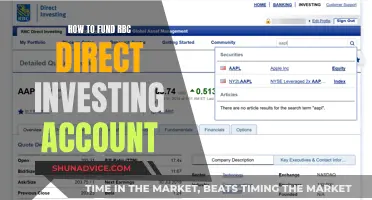
Derivatives are financial instruments based on agreements or contracts whose value is tied to an underlying asset, instrument, or index. They are often used to hedge and manage risk, particularly interest-rate risk. Mutual funds typically invest in traditional asset classes like stocks and fixed-income securities such as bonds, but some also utilize derivatives contracts such as options and futures. These exist as a separate category of mutual funds that specialize in investing in derivative instruments, falling under the more general category of a 'specialty fund'. These funds may be an excellent investment tool for investors who wish to diversify their portfolios with options and futures for various companies' stocks and commodities.
| Characteristics | Values |
|---|---|
| Purpose | To diversify portfolios, enhance returns, generate income, and manage risk |
| Type of Funds | Specialty funds, equity funds, commodities funds, and hedge funds |
| Types of Derivatives Used | Options, futures, forward currency contracts, interest rate swaps, total return swaps, credit default swaps |
| Benefits | Equity taxation, arbitrage opportunities, hedging, portfolio balancing, enhanced returns, reduced risk |
| Risks | Increased volatility, dramatic price changes, leverage risk, liquidity and interest rate risk, market risk, credit risk, management risk |
| Regulatory Bodies | SEBI, U.S. Securities and Exchange Commission |
What You'll Learn

To enhance returns or generate income
Derivatives are financial instruments based on agreements or contracts whose value is tied to an underlying asset, instrument, or index. They are often used to hedge and/or manage risk, such as interest-rate risk. They can also be used to make speculative investments on the movement of the underlying asset's value, to gain exposure to an area that cannot be invested in directly, or to create optionability where the value of the derivative is linked to specific conditions or events.
Mutual funds typically invest in traditional asset classes like stocks and fixed-income securities such as bonds. However, some also utilize derivatives contracts such as options and futures. These fall under the category of 'specialty funds' and can be an excellent investment tool for investors looking to diversify their portfolios with options and futures for various companies' stocks and commodities.
Hedging and Risk Management: Derivatives are commonly used to hedge and manage risk. For example, a mutual fund may use derivatives to protect against rising markets or hedge against a market downturn. This helps to reduce the overall risk of the fund's portfolio.
Speculative Investments: Derivatives can be used to make speculative investments on the movement of the underlying asset's value. For example, a mutual fund may invest in futures contracts or options on a particular stock, betting on its future price movement. This can lead to large profits or losses, depending on the direction of the change.
Exposure to New Areas: Derivatives can provide exposure to areas that may not be accessible through direct investment. For instance, a mutual fund may use derivatives to gain exposure to a specific industry or market without actually purchasing the underlying assets. This allows the fund to diversify its portfolio and access new investment opportunities.
Optionability and Flexibility: Derivatives can create optionability, where the value of the derivative is linked to specific conditions or events. This flexibility allows mutual funds to tailor their investments to their specific needs and strategies. For example, they can use derivatives to hedge against potential losses or generate income through strategies like covered call writing.
Tax Benefits: In some cases, using derivatives in mutual funds can offer tax advantages. For instance, in certain jurisdictions, exposure to derivatives in a mutual fund is treated as equity, which may result in more favourable tax treatment compared to other types of investments.
It is important to note that investing in derivatives can also increase the riskiness of the fund. Investors should carefully consider their risk tolerance and financial circumstances before investing in funds that use derivatives.
Smart Ways to Invest Your Rainy Day Fund
You may want to see also

To hedge against risk
Derivatives are financial instruments that have values derived from other assets like stocks, bonds, or foreign exchange. They are sometimes used to hedge a position (protecting against the risk of an adverse move in an asset) or to speculate on future moves in the underlying instrument.
Hedging is a form of risk management that is common in the stock market, where investors use derivatives to protect shares or even entire portfolios. It is a type of investment strategy intended to protect a position from losses.
A mutual fund that invests in derivatives can use them to hedge against risk. Here are some ways in which derivatives can be used to hedge against risk:
Foreign Exchange Risk
Foreign exchange risk, or currency risk, is the risk that a change in currency exchange rates will adversely affect a company's financial results. For example, a company based in the US but selling products in Germany is exposed to fluctuations in the USD/EUR exchange rate. The company can hedge against this risk by purchasing foreign exchange futures contracts against the USD/EUR exchange rate. This will help minimise the impact of exchange rate fluctuations on their revenue.
Interest Rate Risk
Companies can also use derivatives to hedge against interest rate risk. For instance, a company expecting to receive a large sum of money in the future and wanting to invest it in a risk-free investment can purchase a Treasury futures contract if they believe interest rates will drop. This locks in the future interest rate, protecting them from potential losses if rates drop.
Commodity or Product Input Price Risk
Commodity price risk is another area where derivatives can be used to hedge. Companies that rely heavily on raw materials or commodities can use derivatives to protect against price fluctuations. For example, airlines can use derivatives to hedge against increases in jet fuel prices, while agricultural companies can use them to hedge against fluctuations in the price of soybeans or corn.
Equity Risk
Mutual funds can also use derivatives to hedge against equity risk in their portfolios. One common strategy is the protective put, where the fund buys stock and also buys a put option. This allows them to protect against potential losses if the stock price falls, as they have the right to sell the stock at a specified price (the strike price) within a particular time period.
Another strategy is the covered call, where the fund buys a stock and sells a call option on the same stock. This brings in additional income through the premium received from selling the call option, and can also provide some downside protection if the stock price falls.
Best Tracker Funds: Where to Invest Your Money
You may want to see also

To achieve tax benefits
Mutual funds are a great way to achieve tax benefits. They are professionally managed pools of money that typically invest in stocks and bonds. However, some mutual funds also utilize derivatives contracts, such as options and futures, to enhance returns or generate income. These derivative instruments can provide tax advantages to investors.
One of the key benefits of using derivatives in mutual funds is obtaining equity taxation treatment. In certain cases, exposure to derivatives in a mutual fund is treated as equity for tax purposes. This can benefit specific types of funds, such as arbitrage, equity savings, and balanced advantage funds. By structuring their investments through derivatives, these funds can qualify for more favourable tax rates compared to debt funds.
For example, let's consider an equity savings or balanced advantage fund. These funds may have a limited direct exposure to stocks, but they can use derivatives to increase their overall equity exposure. By doing so, they can exceed the required threshold for equity taxation, which offers more favourable rates than debt funds. This strategy allows investors to benefit from lower tax rates on their investments.
Additionally, mutual funds can provide tax benefits through their ability to distribute income and gains. Mutual funds are pass-through investments, meaning they distribute any income they receive to their shareholders. This distribution can result in tax advantages for investors. For instance, if a mutual fund distributes long-term capital gains, those gains are typically taxed at a lower rate than ordinary income. This can help investors minimize their overall tax liability.
Furthermore, mutual funds can also distribute qualified dividends, which are taxed at the capital gains tax rate instead of the ordinary income tax rate. To qualify, the dividend must be paid by a stock issued by a US or qualified foreign corporation, and the mutual fund must have held the stock for more than 60 days within a specific period. This strategy can further enhance the tax benefits for investors.
Lastly, mutual funds offer tax benefits through their ability to defer taxes. When investors hold mutual funds for an extended period, they can benefit from lower tax rates on their capital gains. The longer the holding period, the lower the tax rate payable on the capital gains. This feature of mutual funds allows investors to maximize their after-tax returns by minimizing the impact of taxes.
Investing Beyond Mutual Funds: Exploring Alternative Investment Avenues
You may want to see also

To make speculative investments
Derivatives are financial instruments whose value is linked to the value of an underlying security. They are used for three broad purposes: hedging, speculation, and arbitrage. This response will focus on the second purpose, speculation.
Speculation involves taking a bullish or bearish position in the underlying security via futures and options. For example, if an investor expects the price of a security to increase, they can take a bullish position by buying a call option. This gives them the right to buy the security at a specified price (strike price) before a specified date (exercise date). If the price does increase, they can exercise the option and book a profit. Conversely, if the price decreases, they can let the option lapse, and their loss is limited to the premium paid for the option.
Similarly, if an investor expects the price of a security to decrease, they can take a bearish position by buying a put option. This gives them the right to sell the security at a specified price before a specified date. If the price does decrease, they can exercise the option and profit. If the price increases instead, they can let the option lapse, and their loss is limited to the premium paid.
Speculating with derivatives offers the potential for higher profits compared to investing directly in the underlying security. This is because the investment via margins or premiums is lower, so any gains or losses are amplified. However, it is important to note that the potential for large losses exists when speculation with derivatives goes wrong.
Mutual funds can use derivatives for speculative purposes to enhance returns. For example, equity mutual funds can use options to generate income through covered call writing. This involves holding a long position in a stock and selling (writing) a call option on the same stock. If the stock price increases, the fund can profit from both the appreciation of the stock and the premium received from writing the call option. If the stock price remains the same or decreases, the fund still receives the premium from writing the call option, which enhances the overall returns of the fund.
While derivatives can provide enhanced returns for mutual funds, it is important to consider the increased riskiness of these investments. The potential for large losses exists when speculation with derivatives goes wrong. Therefore, investors should carefully evaluate the risks and potential benefits before deciding to include derivatives in their portfolios.
Equity Funds: When to Invest for Maximum Returns
You may want to see also

To create optionability
Derivatives are a great tool for mutual fund managers to achieve multiple purposes and create optionability. Optionable stocks provide an advantage to investors by allowing them to hedge their positions in a stock and mitigate the involved risks. This is especially beneficial when a stock is not optionable, as it is harder to hedge positions and mitigate risks in such cases.
Some mutual funds invest in stocks but also hold options with the purpose of minimizing downside risk and volatility in their portfolios. Buying protective puts generally lowers overall returns as the options' premium must be paid, but they also prevent severe losses in a bear market or market crash.
Additionally, mutual funds can engage in covered call writing to generate income. For example, the Gateway Fund Class A Shares (NASDAQ: GATEX) invests primarily in large-cap equities included in the S&P 500 Index. However, the fund sells call options against its portfolio and uses the proceeds to purchase put options, which allows it to hedge its entire portfolio against volatility and sudden large drops in prices.
Another strategy to create optionability is cash-futures arbitrage. This strategy involves taking advantage of the price difference of a share between the cash and futures markets. Fund managers buy a share of a firm in the cash market and simultaneously short (or sell) the stock of the same company in the futures market if it trades at a higher price. This results in a fixed gain that acts as accrual income to the portfolio, similar to interest payouts from bonds.
By utilizing these strategies, mutual funds can create optionability, providing investors with the ability to hedge their positions, mitigate risks, and generate income.
KiwiSaver Investment Funds: Where Does Your Money Go?
You may want to see also
Frequently asked questions
Derivatives are financial instruments based on agreements or contracts whose value is tied to an underlying asset, instrument, or index.
Derivatives are often used to hedge and manage risk. They can also be used to make speculative investments on the movement of the value of an underlying asset, to obtain exposure to an area that it is not possible to invest in directly, or to create optionability where the value of the derivative is linked to a specific condition or event.
Examples of derivatives include futures, options, forward currency contracts, options on future contracts, and swaps such as interest rate swaps, total return swaps, and credit default swaps.
Derivatives are subject to liquidity and interest rate risk, market risk, credit risk, and management risk. They may also experience dramatic price changes and imperfect correlations between the price of the derivative contract and the underlying security or index, which may increase a mutual fund's volatility.







